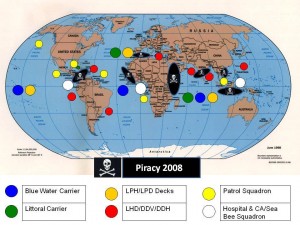
Small Wars Journal
By Robert Haddick August 7, 2009
Climate change and reduced sea ice cover may result in opening up the Arctic to vastly increased resource development and commercial traffic. These trends will inevitably spark international conflicts and create a need for more military forces to provide security and protect interests in the Arctic region. This is bad news for the U.S. Navy, already hard-pressed by shrinking fleets and rising challenges elsewhere.
Rear Admiral David Titley, the U.S. Navy?s top oceanographer, was recently in Barrow, Alaska supervising a global warming research expedition. According to Titley, changes in Arctic sea ice cover will require a new assessment of the Navy?s maritime strategy. Such an assessment will likely recommend changes to military infrastructure in the Arctic, military force structure deployed to the Arctic, and new capabilities to respond to a changing Arctic climate.
The June 2006 issue of the U.S. Naval Institute?s Proceedings journal (registration required) contained an article by Lieutenant Magda Hanna, that described the looming implications of Arctic climate change for resource development, commercial activity, and clashing national interests. Hanna discussed competing subsurface territorial claims; Arctic oil and natural gas potential; sovereignty disputes over Arctic shipping routes, China?s interests in the Arctic; and U.S. Navy and Coast Guard capabilities in the Arctic region. Her conclusion is that significant growth in Arctic commerce, opened up by reduced sea ice, will result in the need for a larger U.S. naval presence in the region.
This added requirement couldn?t come at a more stressful time for the U.S. Navy. The U.S. Navy is down to 285 deployable battle force ships from nearly 600 during the 1980s. Although the U.S. Navy is without question far more powerful than any other navy and will be for many years, it also has global responsibilities, requiring patrolling in many corners of the oceans. Reduced sea ice in the Arctic will add more corners to patrol.
Meanwhile, Navy shipbuilders remain incapable of building new surface warships on time and on budget. In April, Gates terminated the Navy?s next-generation destroyer program and delayed decisions about the next-generation cruiser and amphibious assault ships until after the next Quadrennial Defense Review arrives. Gates ordered an acceleration of Littoral Combat Ship purchases, but that program is plagued with severe cost overruns and contractor problems.
Thus, the Navy faces the prospect of an expanded list of tasks just when it is having the most difficulty getting enough ships to go out on patrol. There is a real risk that an adversary may be able to achieve local superiority over a Navy stretched by these new responsibilities. Climate change is forcing adaptation all around the world, not least inside the Pentagon.
Phi Beta Iota Editorial Comment: The USN lost touch with reality in 1990, along with the rest of the defense and intelligence leadership, when it refused to listen to Commandant of the Marine Corps Al Gray's warning about intelligence challenges of the 1990's. Today they do not have a strategy, cannot build a ship, cannot rearm missile ships underway, and are desperately trying to make SSGN's relevant to Irregular Warfare instead of focusing on an organic 450-ship Navy and a credible global maritime information-sharing and sense-making grid. All that's left of the US Navy is the anchor, and it's at the bottom of the sea.
If and when CNO is ready to listen, we welcome an open dialog in the new USNA auditorium, in front of all midshipmen. Or CNO can dig up the two letters that received polite responses and were in fact blown off. It's time We the People cut off the money for any leadership that will not listen to common sense and engage in holistic strategic thinking. Just to put all this is perspective, see our review of Andrew Jackson Higgins and the Boats That Won World War II. This man turned out an entire Liberty Ship once a day, day after day, and could design, build, and test a landing craft within one 24-hours period. The contrast could not be more powerful.





